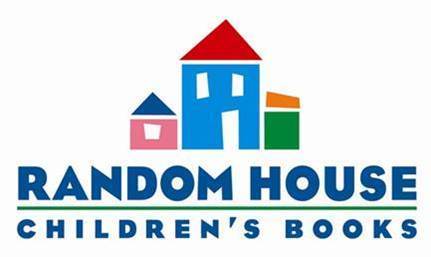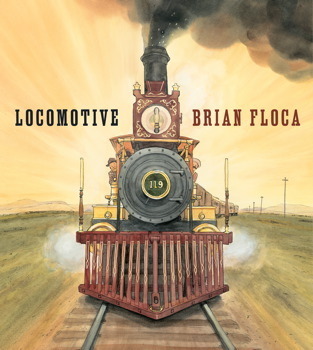Debbie Ridpath Ohi's Blog, page 93
July 17, 2013
Interview: Claire M. Caterer on writing middle grade, getting published and THE KEY AND THE FLAME (Margaret K. McElderry / Simon & Schuster)
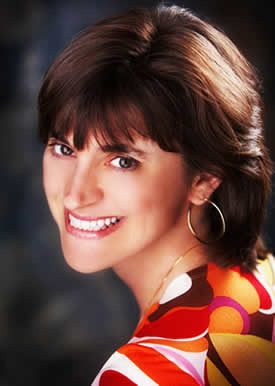 Claire M. Caterer was born in the Motor City and raised in the suburbs of Kansas City with a large assortment of cats, dogs, birds, hamsters, mice, and other creatures. Her childhood was spent reading about and inventing fantastical worlds. Today she is a full-time writer of books for all ages. She lives and writes in the Kansas City area, where she shares her home with one husband, one daughter, two dogs, and a host of imaginary friends. The Key & the Flame is her first novel.
Claire M. Caterer was born in the Motor City and raised in the suburbs of Kansas City with a large assortment of cats, dogs, birds, hamsters, mice, and other creatures. Her childhood was spent reading about and inventing fantastical worlds. Today she is a full-time writer of books for all ages. She lives and writes in the Kansas City area, where she shares her home with one husband, one daughter, two dogs, and a host of imaginary friends. The Key & the Flame is her first novel.
Claire's editor at Margaret K. McElderry is Ruta Rimas, and her agent is Tracey Adams of Adams Literary.
You can find more about Claire at her website, on Facebook and on Twitter.
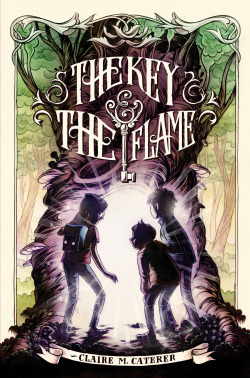 Title: KEY & THE FLAME
Title: KEY & THE FLAME
Written by: Claire M. Caterer
Age range: 8 and up
Published by Margaret K. McElderry Books (Imprint of Simon & Schuster)
About THE KEY & THE FLAME:
Eleven-year-old Holly Shepard wants nothing more than to seek adventure outside of her humdrum American life. She gets her chance at last when her family travels to England and Holly receives an unusual gift: an iron key that unlocks a passage to the dangerous kingdom of Anglielle, where magic is outlawed and those who practice magic are hunted. When her friend Everett and brother Ben are captured by Anglielle’s ruthless king, Holly must rescue them. But that means finding—and using—the magic within herself and learning which magical allies she can trust. The Key & the Flame is the first in a brand-new fantasy adventure series for ages 8 and up.
 Some notes from Claire's pre-writing notebook.
Some notes from Claire's pre-writing notebook.
Q. What was your writing process for THE KEY & THE FLAME?
I used to start with an idea and just see where it took me, but I've discovered that doesn't work very well with an intricate plot. I'd spend too much time rambling and not getting to the story. Also, if I want to weave in subplots, play with time, etc., I have to plan some things out in advance unless I want to have a big spaghetti-like mess on my plate that takes ages to fix.
These days, I usually start with a core idea. But before I start writing any actual words, I doodle. No, not cool cartoony pictures--I don't have that kind of talent--but lots of lists, big capital letters, stars, question marks. For THE KEY & THE FLAME, I had the image of a girl using a tree either to enter a parallel world or to slip into the past. Because trees can be so old--a tree might stand in one place for 200 years—they make the perfect time portal.
 Some of Ruta's edits.
Some of Ruta's edits.
Longhand scribbling is very freeing for me. I fill pages and pages of a notebook with different ideas. Then, as the story starts to crystallize, I go back and highlight those items that resonate most. I might jot down a few broad plot points, like, "Tornado sweeps girl to magical land, girl incurs witch’s wrath, needs to find a way home." (That's THE WONDERFUL WIZARD OF OZ, by the way, not my book.)
Once I know where the story is going and how it will end, I start writing. I usually don’t have all the twists and turns of the plot worked out, but I have the big points in mind. Every few chapters, I’ll chart out how the next few will go. That way I’m never stuck staring at that blank screen.
Q. How did THE KEY & THE FLAME get published?
I took a traditional--which is to say, long--route to publication. I had started writing a novel for adults—my seventh such attempt—and just couldn't get my heart into it. I knew it would be a pretty depressing book, and I was depressed writing it! I put it away and decided to write something for fun--something I'd really love to read and would've loved to read as a kid. The result was THE KEY & THE FLAME. And I knew it was clicking as I was writing it. I couldn't believe I hadn't been writing this kind of stuff all along.
 "My messy office, where Sawyer the dog always snoozes behind my desk chair. In this pic, he's snuggling a friend."
"My messy office, where Sawyer the dog always snoozes behind my desk chair. In this pic, he's snuggling a friend."
Once I’d written and revised the manuscript (many times!), I took a systematic approach to contacting agents. I started by going to AgentQuery.net and narrowing my search by genre (fantasy) and age group (middle grade). Then I went through every name and researched each agent separately.
When I queried a particular agent, I noted exactly why I was considering her--she'd mentioned at a conference that she loved classic fantasy; she’d told a blogger that C.S. Lewis was her favorite writer. Putting that much detail into a query takes time. Each one took about an hour to research and write.
 Books and files in Claire's office.
Books and files in Claire's office.
Chris Richman of Upstart Crow Literary was my top agent pick, but he was inundated with queries and was closed to submissions. So I moved down my list, gathering a big stack of rejections. Some were very nice, as in, "Not this one, but I like your writing, try me again." Some didn't respond at all, which is just what happens. I tried not to take it personally.
After I did another major revision and received about 20 rejections, Chris Richman was finally open to queries again. When I contacted him, he responded the same day with enthusiasm, and we became a team. He was a great agent for THE KEY & THE FLAME. He had me do still more revisions, which took several months, and finally he started subbing out the book in August 2011. By October, we had an offer from Margaret K. McElderry Books, a legendary imprint at Simon & Schuster. After dreaming of publication since childhood, and seriously writing and submitting for about 25 years, I honestly could not believe it was really happening. When Chris called to tell me, I kept saying, “No way—no way!” until he got a little annoyed with me.
Sadly, Chris decided to leave the agenting business this year, and I started my agent search over again. But I’m thrilled to have found Tracey Adams of Adams Literary. She’s marvelous!
 More of Ruta's edits. "See the cute little dinosaur head she drew above? Aww..."
More of Ruta's edits. "See the cute little dinosaur head she drew above? Aww..."
I’ve really enjoyed the editorial process. It’s so exciting to talk about my book with someone else who seems to think the characters are real people. My editor at McElderry is Ruta Rimas, and she’s marvelous. I look forward to getting her questions and seeing her scribbles on the pages. Sometimes she even makes little doodles.
 Inspiration quotes on Claire's bulletin board.
Inspiration quotes on Claire's bulletin board.
Q. What advice do you have for aspiring middle grade writers?
I always say I have six pieces of advice: Read, read, read. Write, write, write.
You positively, absolutely have to be a reader to be a writer. If you want to write for middle grade, read as much of it as you can, both the classics and the current stuff. Analyze it: Why do the old standbys have such staying power? Kids still read LITTLE HOUSE ON THE PRAIRIE and JAMES AND THE GIANT PEACH. Why? And what’s new and exciting for this age group right now?
That said, don't ever read with the idea that you’ll hop on the next hot trend. By the time you have your zombies-in-middle-school novel written, submitted, accepted, edited, and printed, zombies will be long gone and no one will care. Tell the story you want to tell, that you burn to tell.
Which brings me to the writing: You need to do it. A lot. And just as is true of reading, it pays to write lots of different kinds of things. Your muscles stay supple, and the writing doesn't get stale. Sometimes, write for fun, just as an artist doodles for fun. Try your hand at short-short stories and post them on your blog. There's a really fun site that started up early this year, Cabinet of Curiosities, wherein each of the writers submits a creepy story each week. It's fantastic!
The famous science-fiction writer Ray Bradbury recommended writing a story a week for a year. Not everyone has to practice that rigorously, but think about it: If you tried that, how could you NOT improve?
 Claire's research bookshelf.
Claire's research bookshelf.
For writing middle grade, it also helps to be around kids. For years, I volunteered at my daughter's school library once a week. I overheard conversations, watched the kids interact, and as a bonus, got to see what they were interested in reading. If you haven't any kids of your own, see if you can get involved with your local school, church, or library. Go to other authors' events or children's book fairs.
Finally, you have to be able to think and feel like a kid—not how you think kids SHOULD feel, but how they DO feel. What's important to them? What do they dream about? If you have any old school papers or journals of your own, pull them out. Look at old photo albums and try to reach back to your 11-year-old self. Try writing about a day in your kid life as if it's the present. (Warning: This can be an emotional experience.) If you can't access your own kid feelings, you probably should write for adults.
 Some notes from Claire's pre-writing notebook.
Some notes from Claire's pre-writing notebook.
Q. What are you working on now? Any other upcoming events or other info you'd like to share?
Right now my editor and I are working on polishing up the manuscript for the second book in The Key & the Flame series, which is slated to come out in summer 2014. I'm also starting work on the third book as well as kicking around some ideas for standalone novels. I don’t have firm dates yet, but I hope to visit many schools and book festivals this fall. I love finding and connecting with readers!
You can find more about Claire at her website, on Facebook and onTwitter.
------
For more interviews, see my Inkygirl Interview Archive.







July 15, 2013
New Canadian stamps feature picture book character created by children's book author/illustrator, Marie-Louise Gay
Thanks to my sister Ruth for the heads-up:
Stella, the star of Marie-Louise Gay's picture books and a television series based on her stories, is being featured in a series of stamps issued by Canada Post.
I must get some!







Simon & Schuster Children's books affected by the B&N/S&S dispute
I've been gradually updating a list of children's and YA books being affected by the dispute between Simon & Schuster and Barnes & Noble. For more info and to find out how you can help, please see http://inkygirl.com/bn-dispute. If you're a Simon & Schuster Children's author or illustrator affected by the dispute, feel free to fill out my survey.







My sister's book: KENTA AND THE BIG WAVE (Annick Press) available on Netgalley for review
 As some of you already know, my sister Ruth Ohi (photo to the left) is an experienced children's book writer and illustrator who has been encouraging and supporting me over the years.
As some of you already know, my sister Ruth Ohi (photo to the left) is an experienced children's book writer and illustrator who has been encouraging and supporting me over the years.
She has TWO new picture books coming out this year:
KENTA AND THE BIG WAVE, which comes out from Annick Press in a couple of weeks, and FOX AND SQUIRREL, which launches from Scholastic Canada this September. Kenta is now available on NetGalley for reviewers.
I'll be interviewing Ruth later this year but right now I'd like to rave about KENTA AND THE BIG WAVE:

I was fascinated when Ruth told me about a real-life event that (along with other similar reports) helped to inspire the story: Apparently after a soccer ball washed shore in Alaska after the Japan tsunami in 2011, Japanese teen Misaki Murakami came forward as the owner of the ball. More than 3,000 homes were destroyed in Misaki's home city of Rikuzentakata. You can see blog updates by the NOAA technician who found the soccer ball, including info from the teen once they got in touch.
I had the chance to see one of the advance copies of KENTA AND THE BIG WAVE and loved it. Such an uplifting, inspiring story! And the gentle illustration style that Ruth used for this book is perfectly suited to the content.
A quote from a review on Snips and Snails and Puppy Dog Tails:
"I would fully recommend this book for any child (or adult!). It tells the story of the 2011 tsunami that hit Japan, and how a boy lost his ball in it and how a boy in America found it and mailed it back to him. There's very little text, but more isn't needed. Kenta and The Big Wave successfully conveyed that bad things do happen in life, but that people can get over them. The bad things could be small, like losing your ball, or big, like losing your home in a disaster (Kenta lost both), but in the end everything turned out okay. An important message for kids to see."
Here's a brief synopsis, from the Annick Press website:
--------------
The tsunami has swept everything away--including Kenta's most prized possession.
When tragedy strikes Kenta's small village in Japan, he does all he can to hang on to the things that matter to him most. But amidst the chaos of an emergency evacuation brought on by the tsunami, Kenta and his family must quickly leave their home.
Climbing to safer ground, Kenta watches as his prized soccer ball gets swept away by the waves, never to be seen again... that is, until it washes up on a beach on the other side of the world, into the hands of a child who takes it upon himself to return the ball to its rightful owner.
Ruth Ohi's art transports the reader to Japan, capturing the tragic aftermath of environmental catastrophe, while offering a reassuring message of hope. With an afterword that defines tsunamis for young readers.
---------------
You can find out more info here:
My sister's website: RuthOhi.com
KENTA AND THE BIG WAVE on NetGalley







MicroBookTweet: KAT, INCORRIGIBLE by Stephanie Burgis
Reading KAT, INCORRIGIBLE by @StephanieBurgis. Fun MG, Downton Abbey-esque w/ mystery & magic. I am in love with Kat.
— Debbie Ridpath Ohi (@inkyelbows) July 14, 2013

TITLE: KAT, INCORRIGIBLE
Written by Stephanie Burgis
Published by Atheneum Books For Young Readers, 2012
Grades 5-9
ISBN 9781416994480







July 11, 2013
Interview with YA author Chelsea Pitcher, author of THE S-WORD (Gallery Books/Simon & Schuster)
 Chelsea Pitcher is a native of Portland, OR where she received her BA in English Literature. Fascinated by all things literary, she began gobbling up stories as soon as she could read, and especially enjoys delving into the darker places to see if she can draw out some light. The S-Word is her first novel.
Chelsea Pitcher is a native of Portland, OR where she received her BA in English Literature. Fascinated by all things literary, she began gobbling up stories as soon as she could read, and especially enjoys delving into the darker places to see if she can draw out some light. The S-Word is her first novel.
Chelsea's Website - Facebook - Twitter - Blog
Her agent: Sandy Lu (L. Perkins Agency)
Her editor at Gallery Books/Simon & Schuster: Adam Wilson
Title of her book: THE S-WORD
Published by Gallery Books (Imprint of Simon & Schuster) | 320 pages | ISBN 9781451695168 | May 2013
Synopsis of THE S-WORD (also see an excerpt):
First it was SLUT scribbled all over Lizzie Hart’s locker. But one week after Lizzie kills herself, SUICIDE SLUT replaces it—in Lizzie's looping scrawl.
 Lizzie’s reputation is destroyed when she's caught in bed with her best friend’s boyfriend on prom night.
Lizzie’s reputation is destroyed when she's caught in bed with her best friend’s boyfriend on prom night.
With the whole school turned against her, and Angie not speaking to her, Lizzie takes her own life. But someone isn’t letting her go quietly. As graffiti and photocopies of Lizzie’s diary plaster the school, Angie begins a relentless investigation into who, exactly, made Lizzie feel she didn’t deserve to keep living. And while she claims she simply wants to punish Lizzie’s tormentors, Angie's own anguish over abandoning her best friend will drive her deep into the dark, twisted side of Verity High—and she might not be able to pull herself back out.
Buy The S-Word on Powell's - Amazon - Indiebound
Q. What was your writing process for THE S-WORD?
I actually wrote the first draft of THE S-WORD in a month! Sounds crazy, right? But I was attempting NaNoWriMo for the first time, and there’s only one rule: write a 50,000-word novel in thirty days. So all the plotting, planning, and editing-as-I-go had to be thrown out of the window, in order to reach my goal. I couldn’t do anything but sit down and write.
And write I did. I got up early in the morning. I went to bed late at night. I wrote like a crazed, typing fiend and, in the end, I completed my goal one day shy of the deadline. It was a wonderful experience, and a great exercise in discipline. I highly recommend it.
Q. How did THE S-WORD get published?
Once I’d edited and polished that initial draft over a series of months, I started working on my query letter. When I was happy with it, I submitted it to Evil Editor, which is an amazing query critique site. After my query had been sufficiently torn to shreds (er, critiqued), I rewrote it, and started querying agents. Four months (and a handful of rejections) later, I received an offer of representation!
From there, my agent and I worked on the manuscript together to make it as strong as possible. Then she put together a submission list and started reaching out to editors. Six months (and again, quite a few rejections) later, I received a call from my agent. I was at work when the call came in, and had to step into another room to take it. I waited with bated breath as my agent told me an editor was interested in the book. About a week (and several phone calls) later, I had a book deal with Simon and Schuster!
Q. What advice do you have for aspiring YA writers?
I have SO MUCH advice for aspiring YA writers! I’ve compiled a list of what I think are the most important points:
1. Read, read, read! I know this is obvious, but it never hurts to say it again. Also, I want to point out that, while reading YA is imperative for successfully writing YA, definitely don’t limit yourself to one section of the bookstore. Read anything and everything you want, including YA.
2. Write whatever you want (or: Don’t write for trends.) A lot of people feel like they have to follow whatever the Next Big Trend is, and this is a mistake for several reasons. First of all, if you’re writing to please an audience, rather than yourself, you can’t be having as much fun. And writing should be fun, even if it’s also work. Second of all, writing for trends isn’t a good idea time-wise, because what’s hot today won’t necessarily be hot in a year and a half, when your book comes out. So write what you want, and write what you love, no matter how common or unusual it is.
3. Let people critique your work (and I don’t just mean your mom).Find people online (I recommend Critters and the Absolute Write Beta Readers Forum to give you their honest opinion of your work. And then? Compile the data, pay attention to patterns (like, if three out of four readers think your hero falls flat, pay attention. If one out of five readers thinks you need to add a dragon, maybe don’t take their word for it). And, at the end of the day, trust your gut.
If someone’s advice feels wrong, and takes the story in a direction that compromises your vision, it’s okay to ignore it. Just don’t ignore all advice, because critique partners are there to help you succeed.
 Chelsea says she doesn't have an official workspace. "I just take my laptop and work wherever."
Chelsea says she doesn't have an official workspace. "I just take my laptop and work wherever."
4. Research, research, research! (Because writing the book is only half the battle!) Once you’ve got your story written, critiqued and revised, it’s time to look for an agent. But where, oh where, will your agent be?
That’s when the internet comes in handy: you can search for agents on Agent Query, cross reference that information with the agent’s actual website (to make sure the submission guidelines are up to date), keep track of who you’ve queried on Query Tracker, and even get a feel for an agent’s personality on places like Twitter (just no stalking, okay?)
If you follow these four simple rules, you will be well on your way to becoming a YA author. And, if it doesn’t work out with one book, you can always lather, rinse, and repeat ☺

Q. What are you working on now? Any other upcoming events or other info you'd like to share?
Right now I’m working on a YA conspiracy thriller, which is a first for me. I really enjoy challenging myself, attempting to write genres I haven’t tackled before. It’s what I did with THE S-WORD (it was my first contemporary!), and that worked out wonderfully.
In terms of upcoming events, I have really exciting news! I’m going to be at Comic Con, on the “What’s Hot in YA Fiction” panel. If you’re going to the convention, definitely come by and check it out. It’s happening Sunday, July 21st at 11 a.m., and I’ll be in the company of some amazing authors!
Chelsea's Website - Facebook - Twitter - Blog
Some other interviews with Chelsea Pitcher about The S-Word online: OneFourKidlit, The Social Potato, Girls On YA Books, Just Jennifer, Paper Riot, Scattered Pages, Forget About TV: Grab A Book, Rondo Of A Possible World, A.L.Davroe.
------
For more interviews, see my Inkygirl Interview Archive.







July 10, 2013
First meeting re: MITZI TULANE, PRESCHOOL DETECTIVE (and a note about wonderful art directors)
I just had my first phone meeting with Maria Modugno and Cathy Goldsmith about illustrating author Lauren McLaughlin's MITZI TULANE, PRESCHOOL DETECTIVE. The first MITZI title comes out from Random House Children's Books in 2016.
Only just found out that Cathy will be my art director, and I'm especially thrilled because she used to work with Dr. Seuss (!!!).
More about Cathy, from an SCBWI conference bio:
------------
Cathy L. Goldsmith is Vice President and Associate Publisher at Random House Books for Young Readers. She has been with the company for over 34 years and currently supervises the art department of the Random House and Golden Books imprints. Cathy was Dr. Seuss's art director for the last ten years of his life, during which time she worked with him on Hunches in Bunches, The Butter Battle Books, You’re Old Only Once, and Oh, The Places You’ll Go! Cathy has also overseen the creation of the highly successful Step into Reading and Stepping Stones series. Over the years, she has worked extensively with Stan and Jan Berenstain (The Berenstain Bears), Denise Brunkus (Junie B. Jones), Sal Murdocca (Magic Tree House), Jennifer L Holm and Matt Holm (Babymouse and Squish), Marc Brown (Arthur), and many others.
------------
I feel incredibly lucky to be working with such wonderful art directors these days. At Simon & Schuster Children's, the fantabulous Laurent Linn has been guiding me through I'M BORED and NAKED!, two hilarious picture books written by Michael Ian Black:
And I'm so looking forward to working with the amazing Margo Rago at HarperCollins Children's Books on the RUBY ROSE books, written by Rob Sanders:
 Photo from ArtBeats site.
Photo from ArtBeats site.
So many great projects in the pipeline over the next couple of years! Can't wait. :-)







July 9, 2013
Mini-interview: Simon & Schuster Children's publisher and editor Justin Chanda advice for aspiring picture book writers
 Photo: Sonya Sones.Justin Chanda is my amazing editor at Simon & Schuster Books For Young Readers.
Photo: Sonya Sones.Justin Chanda is my amazing editor at Simon & Schuster Books For Young Readers.
I will always be grateful to Justin for being the first editor to believe in me and my work enough to offer a book contract (see this post for Justin's explanation of why he chose me to illustrate I'M BORED). Justin is also publisher of three flagship children's imprints at Simon & Schuster Children's: Atheneum Books for Young Readers, S&S Books for Young Readers and Margaret K. McElderry Books, where he is responsible for the publication of 150 - 200 Trade titles per year ranging from picture books to young adult.
Q. In your experience as a children's book editor, what do you find is the biggest mistake that aspiring picture book writers tend to make?
 The one that I see most often, and it covers a multitude of sins, is they do not take the time to really hone their project. Writers have so many ideas they want to work on one, move on to the next, flood an editor with a bunch of projects… Thing is, picture books take time. There is craft, there is fine tuning, there is CUTTING OF TEXT. All of this takes time. A book needs to be read aloud. It needs to be tweaked and made sure that every word is there for a reason — a good reason. Rushing to get through, or assuming that short = easy or quick is a recipe for disaster.
The one that I see most often, and it covers a multitude of sins, is they do not take the time to really hone their project. Writers have so many ideas they want to work on one, move on to the next, flood an editor with a bunch of projects… Thing is, picture books take time. There is craft, there is fine tuning, there is CUTTING OF TEXT. All of this takes time. A book needs to be read aloud. It needs to be tweaked and made sure that every word is there for a reason — a good reason. Rushing to get through, or assuming that short = easy or quick is a recipe for disaster.
That and thinking rhyming solves everything are the biggest mistakes.
Q. What upcoming book releases are you especially excited about?
As an editor: there is this hilarious book NAKED! coming out that I think you might have heard of.
As a publisher, Oh, my there are SO MANY things coming out this year that I am dying over. But I have to say that Brian Floca's LOCOMOTIVE is a freakin' masterpiece.
You can find Justin on Twitter and on Facebook.
------------------
For more interviews, see my Inkygirl Interview Archive.







July 8, 2013
Interview with MG author Stephanie Burgis: creative process, childhood wonder and STOLEN MAGIC (Atheneum/Simon & Schuster Children's)
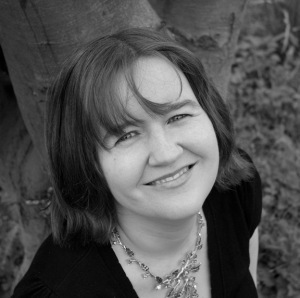 Stephanie Burgis was born in Michigan, but now lives in Wales with her husband, fellow writer Patrick Samphire, and their children. Before becoming a fulltime writer, she studied music history as a Fulbright Scholar in Vienna, Austria and worked as a website editor for a British opera company. Her first novel, Kat, Incorrigible, won the Waverton Good Read Children's Award in 2011 (under its UK title, A Most Improper Magick) for Best Début Children's Novel by a British writer. It was followed by Renegade Magic and Stolen Magic. Cover art for the UK books was created by Anne-Yvonne Gilbert (first two books) and Will Steele (third book), while Annette Marnat did the U.S. covers.
Stephanie Burgis was born in Michigan, but now lives in Wales with her husband, fellow writer Patrick Samphire, and their children. Before becoming a fulltime writer, she studied music history as a Fulbright Scholar in Vienna, Austria and worked as a website editor for a British opera company. Her first novel, Kat, Incorrigible, won the Waverton Good Read Children's Award in 2011 (under its UK title, A Most Improper Magick) for Best Début Children's Novel by a British writer. It was followed by Renegade Magic and Stolen Magic. Cover art for the UK books was created by Anne-Yvonne Gilbert (first two books) and Will Steele (third book), while Annette Marnat did the U.S. covers.
To find out more, or to read the first three chapters of each of her books, please visit her website.
Synopsis of Stephanie's Kat series:
*Magic, romance and adventure in Jane Austen's Regency England!* Twelve-year-old Kat Stephenson may be the despair of her social-climbing Step-Mama, but she was born to be a magical Guardian and protector of Society--if she can ever find true acceptance in the secret Order that expelled her own mother.
She’s ready to turn the hidebound Order of the Guardians inside-out, whether the older members like it or not. And in a society where magic is the greatest scandal of all, Kat is determined to use all her powers to help her three older siblings--saintly Elissa, practicing-witch Angeline, and hopelessly foolish Charles--find their own true loves, even if she has to turn highwayman, battle wild magic, and confront real ghosts along the way!
 Covers for U.S. edition, which was published by Atheneum/Simon & Schuster Children's. Cover art by Annette Marnat.
Covers for U.S. edition, which was published by Atheneum/Simon & Schuster Children's. Cover art by Annette Marnat.
Q. What was your writing process for the Kat trilogy? Did it change by the time you wrote the third in the series, STOLEN MAGIC?
When I wrote my first Kat book, Kat, Incorrigible, I had a really wonderful, luxurious and relaxed writing process. Every morning, I would brew a perfect cup of Earl Grey tea, drop a few squares of dark chocolate onto a plate, and spend at least ten or twenty minutes re-reading the collected letters of Jane Austen. Mmm. I love Austen's letters! They're funny and scathing and they give an amazing view into Regency society - especially what the women were up to every day! They were just perfect for putting me in that Regency-era headspace for my writing sessions. Austen's sharp, acerbic and very adult voice was totally different from the voice of my twelve-year-old Kat, but by the end of each of those reading sessions, I always felt wonderfully re-absorbed into the Regency world, and absolutely ready to write in a "period" voice. I handwrote many scenes before typing them into the computer, and I even kept a figurine of Jane Austen sitting on my desk during my writing sessions!
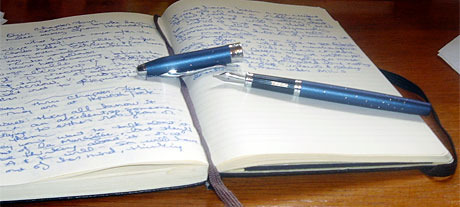 Stephanie's Kat notebook
Stephanie's Kat notebook
But then...well, then I had my first child and - surprise, surprise! - life changed. A lot! Suddenly, I didn't have all day to work on my book, on and off. I couldn't just write until my energy wore out. (I have M.E./CFS, so this is a real issue for me.) Instead, I had...my baby's nap times! In his first year of life, I couldn't even set my baby down as he napped - I had to type (skipping the first handwriting step) while he lay sleeping on my lap, never moving my arms too much in case I woke him up.
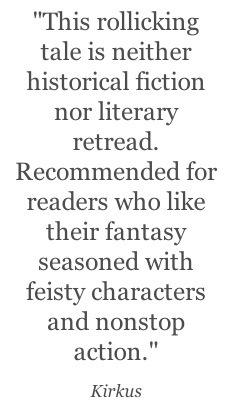 But I also had deadlines - real, scary publishing deadlines that could not be missed. Suddenly, I had to get a WHOLE LOT more efficient with my writing time! I kept the dark chocolate as my writing fuel - no way could I ever give that up! - but alas, I had to abandon my lovely pre-writing routine of letter-reading! I no longer had time to sloooowly sink into the mood of my novel. I had to dive in and use every minute I had!
But I also had deadlines - real, scary publishing deadlines that could not be missed. Suddenly, I had to get a WHOLE LOT more efficient with my writing time! I kept the dark chocolate as my writing fuel - no way could I ever give that up! - but alas, I had to abandon my lovely pre-writing routine of letter-reading! I no longer had time to sloooowly sink into the mood of my novel. I had to dive in and use every minute I had!
Since then, of course, he's gotten older, life has changed again, and by the time he was two, we were hiring part-time childcare for him, which meant that I suddenly had (amazing! decadent!) two-hour writing sessions instead of scattered 45-minute sessions to help me finish Book 3, Stolen Magic. But by then, I'd actually figured out that I didn't need the letter-reading or the handwriting anymore. Instead, I'd devised new ways of clicking quickly into the mood of my book.
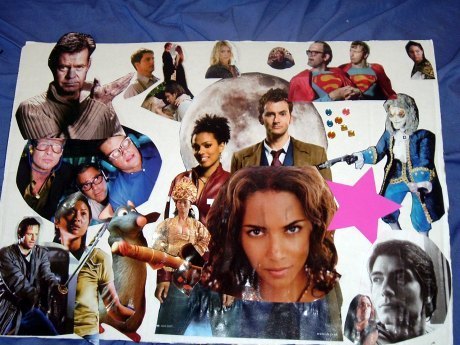 From Stephanie: "Early in the process, I sat down to make a collage to help myself figure out what was going on: what really mattered in the book, how people's stories and character arcs interacted with each other, and so on. Here's the collage that I made that day."
From Stephanie: "Early in the process, I sat down to make a collage to help myself figure out what was going on: what really mattered in the book, how people's stories and character arcs interacted with each other, and so on. Here's the collage that I made that day."
First of all, I got *really* serious about putting together musical playlists for each book, so that I could turn on that particular music and immediately clue in my subconscious: this is writing time! Get to work! The process felt pretty Pavlovian...and it honestly helped a LOT. I also made visual collages for each book, which I could prop in front of my desk (or nursing chair) to give me another strong visual cue to get me in the mood of my book.
(Since then, of course, Pinterest has been invented - woooot! I am addicted! - and my Pinterest inspiration boards there have replaced the paper-and cardboard collages I used to make. Nowadays, whenever I'm working on my new WIP, I have its Pinterest inspiration board open as my desktop wallpaper. But while I was writing the Kat books, my visual collaging process was still all about cardboard, magazines, and glue.)
Q. What advice do you have for aspiring middle grade writers?
One of the things I love most about writing MG fiction - especially MG fantasy - is the audience. MG readers are still so open to a sense of wonder, undisguised by any cynicism. Every time I visit a school, I get so charged up by my interactions with the kids there - their openness and their unhidden excitement. As an MG fantasy writer, I try to put myself back into that emotional place, too, tapping into that core sense of freshness and wonder.
MG readers are old enough to follow complex, twisting plots and to understand big concepts, but they're also young enough to be excited by all the things they haven't discovered yet. As an MG writer, my personal feeling is that it's my job to write for these kids with emotional honesty, hope and respect - and to never the social rules I learned as a teenager and an adult ("Don't get too excited in public! Don't show your emotions too openly! Keep some cynicism as a protective shell!") get in the way of writing with real enthusiasm and wonder.
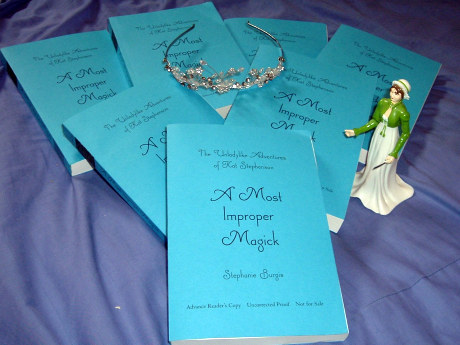 ARCs for the UK version of KAT, INCORRIGIBLE
ARCs for the UK version of KAT, INCORRIGIBLE
Q. What are you working on now? Any other upcoming events or other info you'd like to share?
Since writing Stolen Magic, the final book in my trilogy, I've actually drafted two new books! They're each very different from each other...and they're both going out on submission to editors this year! I honestly have no idea which one will be my next published book. Please wish them both luck! The one common ground they share is that they're both MG fantasy adventures with strong, smart heroines and deeply important relationships between girls. One of them is set in 1930s America, with ghosts and gangsters; the other is a funny, contemporary family novel set in a magical house-between-worlds. I really hope to be able to share them both with readers in the next few years!
Where to find more info about Stephanie Burgis and her work:
Stephanie's website - Twitter - Pinterest
-------
For more interviews, see my Inkygirl Interview Archive.
 Cover art for the UK books was created by Anne-Yvonne Gilbert (first two books) and Will Steele (third book)
Cover art for the UK books was created by Anne-Yvonne Gilbert (first two books) and Will Steele (third book)







July 7, 2013
MicroBookTweet: ARISTOTLE AND DANTE DISCOVER THE SECRETS TO THE UNIVERSE
Just read ARISTOTLE AND DANTE DISCOVER THE SECRETS OF THE UNIVERSE. Totally lives up to all the hype. My heart is full.
— Debbie Ridpath Ohi (@inkyelbows) July 2, 2013
ARISTOTLE AND DANTE DISCOVER THE SECRETS OF THE UNIVERSE
By Benjamin Alire Saenz
Simon & Schuster Books For Young Readers
Also see my other MicroBookReviews.













